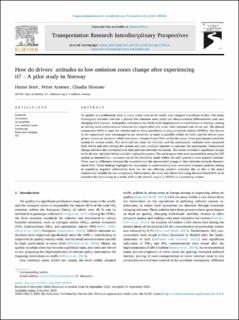| dc.contributor.author | Seter, Hanne | |
| dc.contributor.author | Arnesen, Petter | |
| dc.contributor.author | Moscoso Paredes, Claudia Trinidad | |
| dc.date.accessioned | 2023-10-16T07:27:30Z | |
| dc.date.available | 2023-10-16T07:27:30Z | |
| dc.date.created | 2023-10-03T09:34:21Z | |
| dc.date.issued | 2023 | |
| dc.identifier.uri | https://hdl.handle.net/11250/3096620 | |
| dc.description.abstract | Air quality is a problematic issue in many urban areas in the world, and transport contributes to this. This study investigates attitudes towards a piloted low emission zone (LEZ) and distance-based differentiated road user charging (RUC) system. Both policy instruments are likely to be implemented in combination in Norway, aiming at curbing local environmental issues in the largest cities and cover other external costs of car use. The piloted system uses GNSS to track the vehicles and we focus specifically on plug-in hybrid vehicles (PHEVs). The drivers in the experiment were encouraged to use electricity as much as possible within the LEZs, and the drivers were given a monetary incentive which simulates a distance-based RUC within the zones. Forty participants tested the system for several weeks. The technical data from the vehicles, and the participants' attitudes were measured both before and after testing the system and were analysed together to measure the participants' behavioural change and how this correlated with their attitudes towards the system. The results revealed a significant change in the drivers' attitudes before and after testing the system. The participants who were successful in using the LEZ system as intended (i.e. increased use of the electricity mode within the LEZ) gained a more positive attitude. There was no difference between the successful and the unsuccessful groups in their attitudes towards distance-based RUC. These findings highlight the importance of understanding how innovative transport policies aiming at regulating negative externalities from car use are affecting people's everyday life, as this is the major explanatory variable for user acceptance. Furthermore, the study also shows that using distance-based RUC as an incentive for stimulating to a mode shift to the electric engine in PHEVs is a promising avenue. | en_US |
| dc.language.iso | eng | en_US |
| dc.publisher | Elsevier | en_US |
| dc.rights | Navngivelse 4.0 Internasjonal | * |
| dc.rights.uri | http://creativecommons.org/licenses/by/4.0/deed.no | * |
| dc.subject | Acceptance | en_US |
| dc.subject | Acceptability | en_US |
| dc.subject | Low emission zones | en_US |
| dc.subject | Geofencing | en_US |
| dc.subject | Road user charging | en_US |
| dc.subject | ITS | en_US |
| dc.title | How do drivers' attitudes to low emission zones change after experiencing it? – A pilot study in Norway | en_US |
| dc.type | Peer reviewed | en_US |
| dc.type | Journal article | en_US |
| dc.description.version | publishedVersion | en_US |
| dc.rights.holder | © 2023 The authors | en_US |
| dc.subject.nsi | VDP::Samfunnsvitenskap: 200 | en_US |
| dc.source.volume | 22 | en_US |
| dc.source.journal | Transportation Research Interdisciplinary Perspectives (TRIP) | en_US |
| dc.identifier.doi | 10.1016/j.trip.2023.100934 | |
| dc.identifier.cristin | 2181182 | |
| dc.source.articlenumber | 100934 | en_US |
| cristin.ispublished | true | |
| cristin.fulltext | original | |
| cristin.qualitycode | 1 | |

